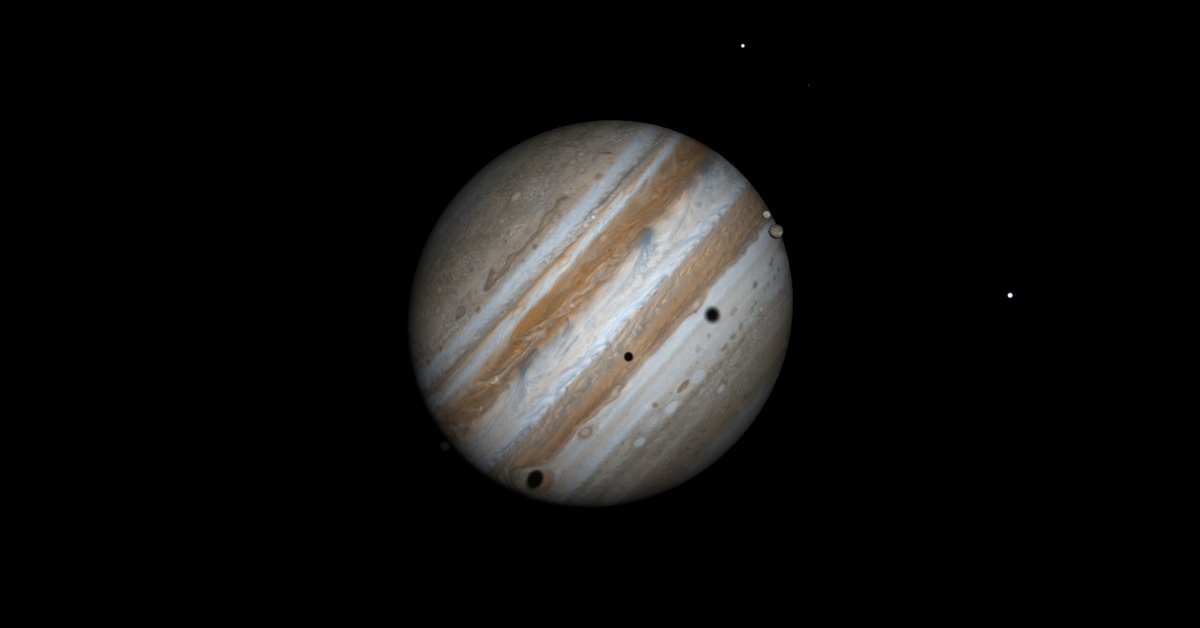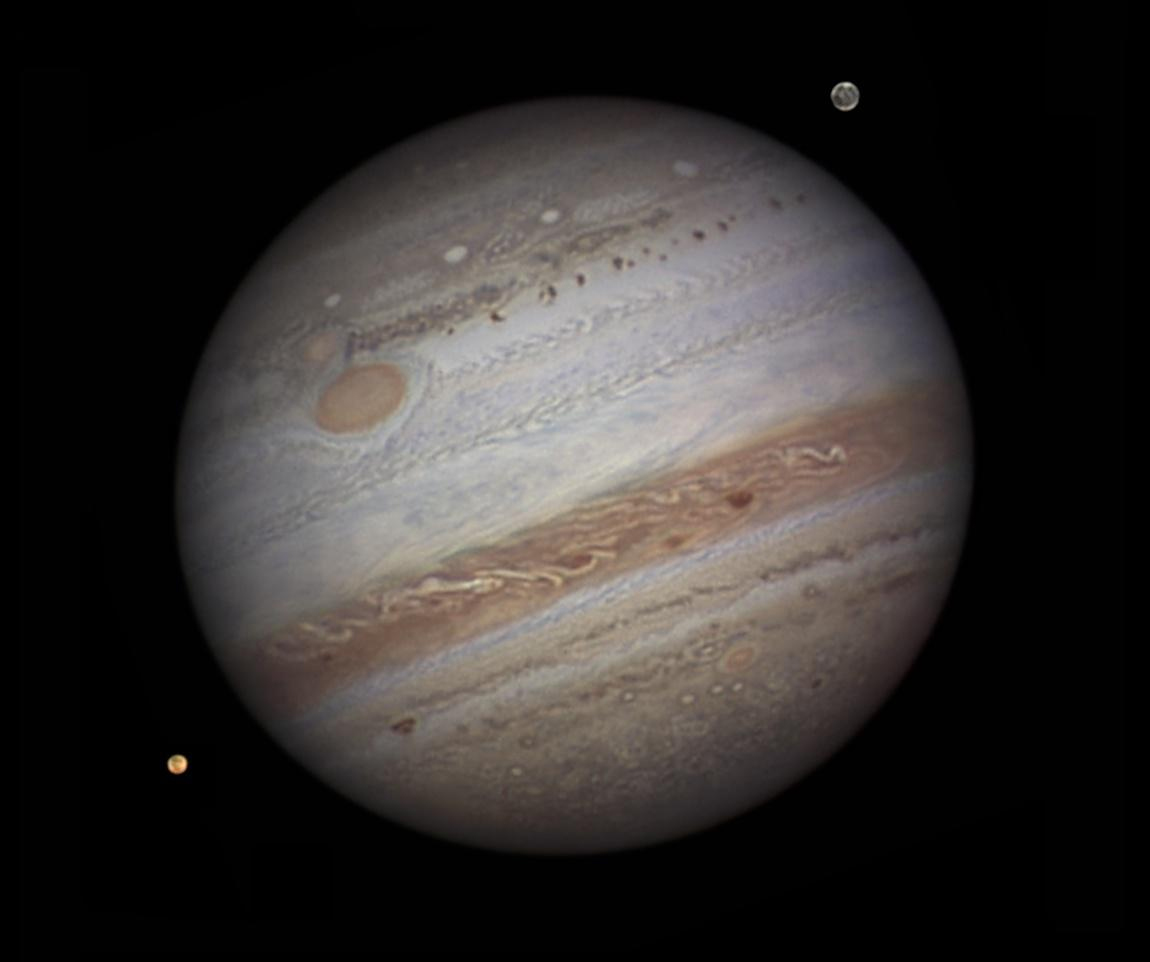3 Jupiter Moons Perform Celestial Shadow Dance Next Week

Three of Jupiter's moons will cast their dark shadows on the face of the giant planet Tuesday (June 3), but you might need a computer in order to see it.
Most owners of small telescopes enjoy watching the dance of Jupiter’s four largest moons, first observed by Galileo in 1609. As these moons circle Jupiter, they often pass in front of the giant planet, casting their tiny shadows on its face. Although these shadows are very small, they are also intensely black, appearing like tiny drops of ink on the bright surface of Jupiter’s cloud deck.
These shadows can be observed with telescopes as small as 90 mm aperture, widely available to amateur astronomers. [The Galilean Moons of Jupiter (Photos)]
Such shadow transits are quite frequent, occurring as often as once every 42 hours in the case of Io, Jupiter’s innermost satellite. It is much more rare for two satellites to be placed so that their shadows fall on Jupiter simultaneously, and rarer still for three satellites. Four satellites? That can never happen because Jupiter’s moons are in a precise mathematical relationship with on another such that all four satellites can never find themselves on the same side of the planet at the same time.
This triple transit is a difficult toview from the surface of Earth. Jupiteris now approaching the time of year when it passes behind the sun, and is lost to view for a couple of months. There’s only a short window when skywatchers can observe Jupiter each night. That period of time takes place between sunset, and the time when Jupiter is too low to be observed, lost in the turbulence of Earth’s atmosphere.
Let’s take a look at what will happen on Tuesday:
3:57 a.m. EDT (0757 GMT) – Callisto begins to cross in front of Jupiter.
Get the Space.com Newsletter
Breaking space news, the latest updates on rocket launches, skywatching events and more!
8:01 a.m. EDT (1201 GMT) – Callisto finishes its transit of Jupiter.
10:56 a.m. EDT (1456 GMT) – Ganymede begins to cross in front of Jupiter.
11:24 a.m. EDT (1524 GMT) – Callisto’s shadow begins to cross Jupiter.
11:35 a.m. EDT (1535 GMT) – Europa begins to cross in front of Jupiter.
11:57 a.m. EDT (1557 GMT) – Io disappears behind Jupiter.
1:08 p.m. EDT (1708 GMT) – Europa’s shadow begins across Jupiter (that’s two shadows).
2:08 p.m. EDT (1808 GMT) – Ganymede’s shadow begins to cross, making it three shadows.
2:18 p.m. EDT (1815 GMT) – Three shadows are on Jupiter: Ganymede, Europa, and Callisto from left to right. Europa and Ganymede themselves are about to move off Jupiter’s disk, smaller Europa just above larger Ganymede. Notice that, because of the angle from which the Sun is shining, over your right shoulder, the shadows of these two moons are widely separated.
2:16 p.m. EDT (1816 GMT) – Ganymede moves off Jupiter’s disk.
2:18 p.m. EDT (1818 GMT) – Europa moves off Jupiter’s disk.
3:02 p.m. EDT (1902 GMT) – Io reappears from Jupiter’s shadow.
3:44 p.m. EDT (1944 GMT) – Callisto’s shadow moves off Jupiter, 4 hours and 20 minutes after it entered.
3:53 p.m. EDT (1953 GMT) – Europa’s shadow moves off Jupiter, 4 hours and 18 minutes after entering.
5:33 p.m. EDT (2133 GMT) – Ganymede’s shadow moves off, 3 hours and 18 minutes after it entered.

While it won't be easy to see the transit from Earth's surface, it's still possible. There is only a narrow band on Earth where the sun has set but Jupiter is still reasonably high in the sky. Where is that band?
A planetarium program like Starry Night lets you figure this out. The most interesting point in this triple transit is just after the third shadow will enter onto Jupiter’s disk and just before Ganymede will move off at about 2:15 p.m. EDT (1815 GMT).
At this time, Jupiter is high in the sky, but the sun is even higher in the sky. A computerized telescope can locate Jupiter in the sky in broad daylight, but it would be too dim to spot the tiny shadows of Jupiter’s moons. By the time the sun has set all three shadows will be long gone from Jupiter. [See amazing night sky photos for May 2014]
So, where would be a good viewing location? Let’s concentrate on that critical time: 2:15 p.m. EDT (1815 GMT). If we set Starry Night to that time and switch our viewing location to Jupiter, we can then look back towards Earth and see where the sun has just set at that time. The sunset terminator lies across Eastern Europe, and a good viewing location would be Kiev, Ukraine.
In Kiev, sunset will be a 9:03 p.m. local time, just a few minutes before Ganymede’s shadow enters the disk at 9:08. Jupiter will still be 22 degrees above the western horizon, high enough for a good view.
Modern planetarium software can act as our time machine to view future or past events, and also lets us travel in space to view these events from the perfect location.
This article was provided to Space.com by Simulation Curriculum, the leader in space science curriculum solutions and the makers of Starry Night and SkySafari. Follow Starry Night on Twitter @StarryNightEdu. Follow us @Spacedotcom, Facebook and Google+. Original article on Space.com.
Join our Space Forums to keep talking space on the latest missions, night sky and more! And if you have a news tip, correction or comment, let us know at: community@space.com.

Geoff Gaherty was Space.com's Night Sky columnist and in partnership with Starry Night software and a dedicated amateur astronomer who sought to share the wonders of the night sky with the world. Based in Canada, Geoff studied mathematics and physics at McGill University and earned a Ph.D. in anthropology from the University of Toronto, all while pursuing a passion for the night sky and serving as an astronomy communicator. He credited a partial solar eclipse observed in 1946 (at age 5) and his 1957 sighting of the Comet Arend-Roland as a teenager for sparking his interest in amateur astronomy. In 2008, Geoff won the Chant Medal from the Royal Astronomical Society of Canada, an award given to a Canadian amateur astronomer in recognition of their lifetime achievements. Sadly, Geoff passed away July 7, 2016 due to complications from a kidney transplant, but his legacy continues at Starry Night.









